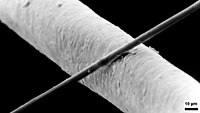
Photo from wikipedia
Abstract Moisture penetration and the age-related degradation of parts made with Fused Filament Fabrication (FFF) using PolyLactic Acid (PLA), Silicon Carbide (SiC) filled PLA composites, and Acrylonitrile Butadiene Styrene (ABS)… Click to show full abstract
Abstract Moisture penetration and the age-related degradation of parts made with Fused Filament Fabrication (FFF) using PolyLactic Acid (PLA), Silicon Carbide (SiC) filled PLA composites, and Acrylonitrile Butadiene Styrene (ABS) are reported in this paper. The hygroscopic stability of the PLA and PLA/SiC composite parts is compared with those printed with Acrylonitrile Butadiene Styrene (ABS). Both filaments and tensile test samples were aged at 50 °C and 70 °C in distilled water. The specimens were aged for 140 days or until they completely degraded. The degradation of the polymer was identified by observing the differences in the moisture absorption-desorption characteristics and the tensile strength degradation. The results of the experimental assay show that PLA and 20 wt% SiC/PLA specimens degrade in 58 days at 50 °C, while higher loadings of SiC/PLA retain their stability for 140 days. Moisture diffusivity decreased with the increase in SiC loading. While the addition of 20 wt% SiC loading increased both the tensile strength and failure strain of PLA, both these measures declined for other higher SiC loadings. The addition of SiC did not show substantial improvement in the aged properties. ABS retained its tensile strength during aging. However, the stiffness of ABS parts decreased, and the failure strain increased, indicating that the material was subjected to moisture-related softening. Digital image correlation results show that the morphology and the properties of the printed parts have considerable variability at both microstructural and part-level scales. The evolution of strain fields during loading shows the periodic arrangement of local microstructure caused by the printing process.
Journal Title: Additive manufacturing
Year Published: 2020
Link to full text (if available)
Share on Social Media: Sign Up to like & get
recommendations!